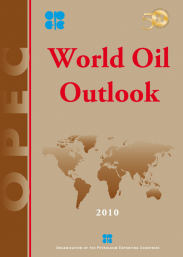
World Oil Outlook 2010

Executive Summary (excerpt)
The emergence of oil as an asset class has led to higher price swings The appeal of investing in commodities, including oil, has increased significantly over the last five years. Previously, the paper oil market was dominated by commercials that used futures and over-the-counter markets to hedge price risk. In more recent times, however, there has been a rapid increase in the participation of non-commercials, looking for higher returns from a rise or a fall in the oil price and/or seeking diversification of their investment portfolio. The growing involvement of investment banks and funds has provided opportunities to generate returns from the performance of oil derivatives (futures, options and swaps), and, as a result, oil has evolved with other commodities into an asset class. This has been helped by the issuance of the US Commodity Modernization Act in 2000 and by low interest rates. As a consequence, the volume of money going into paper oil has increased and trading volumes have risen dramatically. A number of steps are now being taken to introduce regulatory reforms to financial markets, including commodities markets. It remains to be seen how effective these reforms are in mitigating the effects of speculation in exacerbating price fluctuations, when trending both upward and downward, and in preserving sufficient liquidity to allow markets to properly perform their price discovery and risk transfer functions.
View all published World Oil Outlook reports here.
- Issue:
- Natural Resources
- Region:
- Global
- Year Published:
- 2010
- Institution:
- Organization of the Petroleum Exporting Countries (OPEC)

